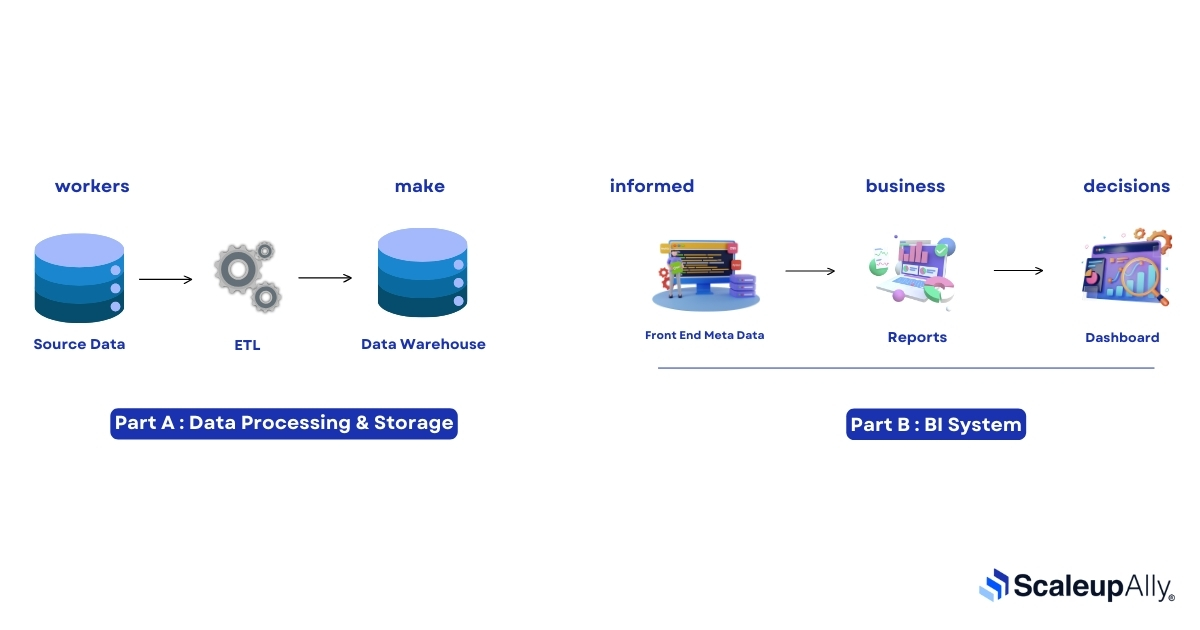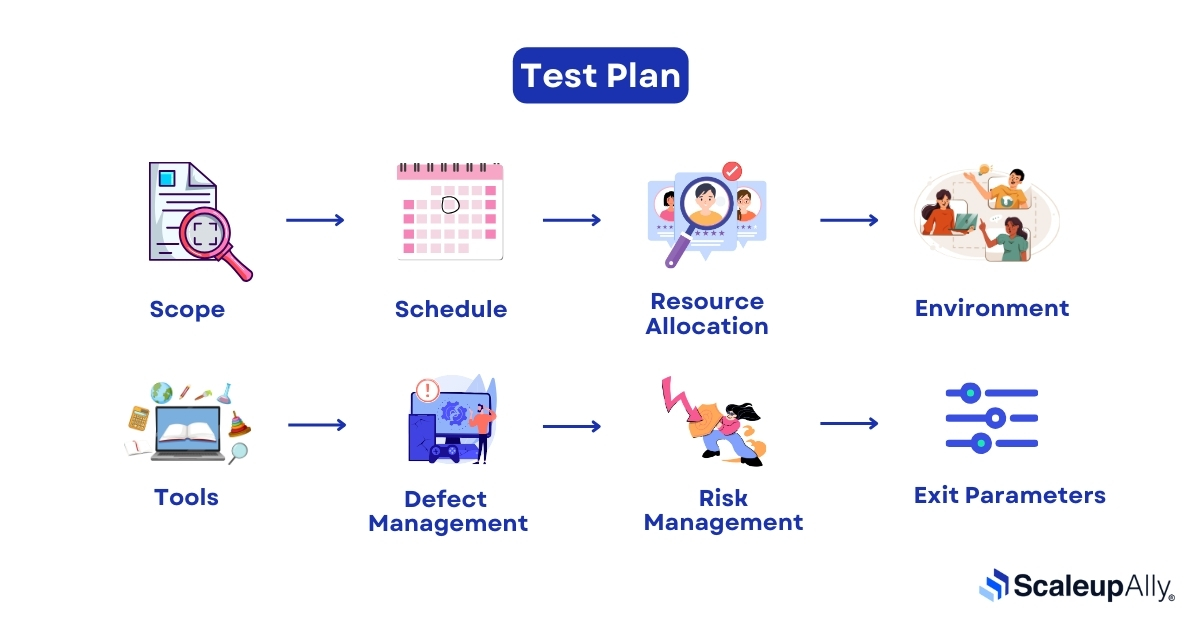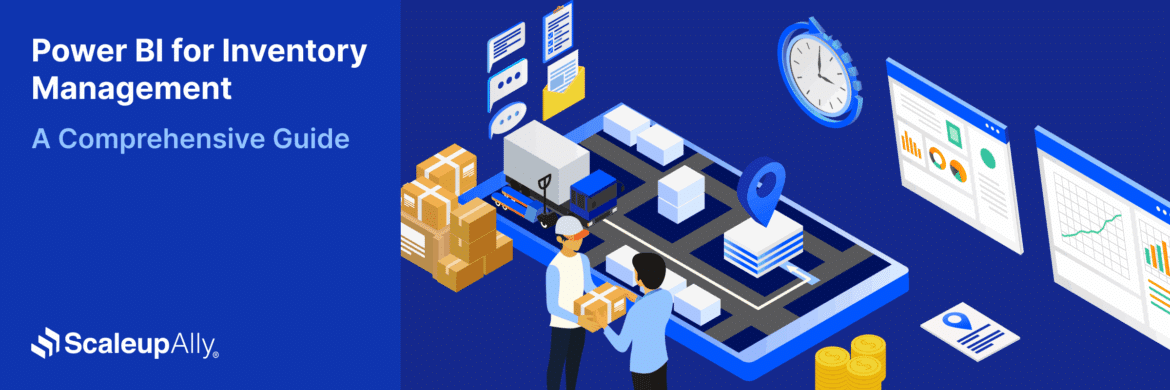
BI Testing: A Comprehensive Guide For 2025
ScaleupAlly Team | April 4, 2025 , 18 min read
Table Of Content
As organizations increasingly rely on BI systems to transform raw data into actionable insights, the importance of ensuring the accuracy, reliability, and performance of these systems cannot be overstated.
But how do you ensure your BI tools are delivering trustworthy insights? Enter BI Testing—a crucial process that validates data quality, system performance, and security, empowering businesses to make informed decisions confidently.
In this comprehensive guide to BI testing, we’ll explore:
- The fundamentals of BI Testing and why it matters.
- Key types of BI Testing, including data quality, performance, and security testing.
- The benefits of BI Testing, from improving decision-making to enhancing system reliability.
- A step-by-step process to conduct BI Testing effectively.
- Challenges you may encounter and how to overcome them.
Whether you’re a business leader, data analyst, or IT professional, this guide will equip you with the knowledge to ensure your BI systems are both robust and accurate.
Key Takeaways
-
Accurate data empowers better decisions: Rigorous testing ensures you can trust every insight.
-
Automation streamlines checks: Reduce manual effort and error-prone tasks with automated tools.
-
User involvement is critical: Engaging end-users helps uncover real-world flaws and boosts adoption.
-
Security is non-negotiable: Protecting sensitive information must remain a top priority throughout testing.
-
Comprehensive planning pays off: Clearly defining objectives, scope, and processes fortifies BI testing outcomes.
What is BI Testing?
BI Testing or Business Intelligence Testing is a process of verifying and validating the accuracy and reliability of insights delivered by BI & Analytics platforms.
It is a technology-driven process for analyzing data and delivering actionable information that helps executives, managers and workers make informed business decisions.

Types of Business Intelligence Testing
BI testing tools include four areas on which a BI tester does the testing of the Report or Dashboard:
- Data Quality Testing: In this, BI tester checks whether the data in the BI system is accurate, complete, consistent, and up to date or not.
- Report & Dashboard Testing: BI Tester evaluates how reports and dashboards function within the BI system, how easily users can interact with them, and how effectively they present data.
- Performance Testing: Here, BI Tester examines how the BI system performs under different workloads and user scenarios.
- Security Testing: In this, BI tester ensures that the sensitive data within BI systems is protected from unauthorized access by identifying and addressing vulnerabilities, if any.
5 Benefits of BI testing
1. Data Accuracy and Quality
BI testing makes sure that the data being processed and analyzed is both accurate and consistent, which is vital for avoiding errors in decision-making.
Relying on inaccurate data can lead to major strategic and operational mistakes, so testing acts as a data reliability cushion.
Some of the key Qualities that are contributed for the data accuracy and Quality are:
- Accuracy: This refers to the precision and correctness of the data.
- Consistency: Here data remains uniform across different datasets and systems, which is essential for preserving data integrity. It involves checking for discrepancies or conflicting data values within a single dataset or between multiple systems.
- Relevance: The data quality will ensure that the data we are having meets the requirements against the current business objectives with respect to their operational context.
- Completeness: The completeness in the data testing is to check if there is any missing field, null or any unavailable field which are essential for comprehensive analysis.
2. Improved Decision-Making
BI tester ensures that BI systems deliver precise and dependable data, which strengthens senior management’s ability to make well-informed decisions.
Reliable, high-quality data results in deeper insights and supports more effective decision-making.
Different ways a BI testing will help in better decision making:
- Business Rule Verification: BI testing verifies that business rules, including calculations, aggregations, and key performance indicators (KPIs), are accurately applied. This enables the insights generated to be dependable, providing greater confidence among decision-makers.
- Performance and Scalability: BI testing evaluates the performance and response times of systems under varying workloads. Since decision-makers require fast access to data, any delays can hinder important choices. By conducting tests, the user makes the BI systems both responsive and capable of scaling smoothly.
- Data Protection and Accuracy: Testing verifies that data access controls are correctly implemented, ensuring that sensitive information remains secure. This is of high concern for decision-makers, as they need to be confident about their data’s security, particularly when dealing with confidential business information.
- Consistency Across Reports: BI Testing ensures that reports and dashboards are consistent across various platforms, enabling decision-makers to trust the information regardless of where or how it is accessed.
3. System Reliability and Performance
Consistent testing uncovers and fixes performance issues and reliability concerns in BI systems. The applications then can efficiently manage high data volumes and complicated queries, offering insights promptly and without system interruptions.
4. Client Contentment
By establishing that information is both precise and promptly delivered, BI testing enhances user trust and satisfaction. When users can count on the accuracy and dependability of the data, they are more inclined to depend on the BI system.
There are ways in which the BI testing help in proper client satisfaction:
- Data Precision: By verifying the accuracy of data in reports and dashboards, BI testing helps avoid errors that might cause customer frustration or mistrust. Reliable data boosts customer confidence in the services or products provided.
- Improved User Experience: BI testing evaluates the usability and functionality of dashboards and reports to ensure they are user-friendly and easy to navigate. When users have a positive experience, it enhances customer satisfaction, as they can effortlessly access and comprehend the information they need.
- Real-Time Insights: Performance testing guarantees that BI systems deliver data promptly, allowing customers to obtain real-time insights without any delays. This swift responsiveness enhances decision-making and boosts overall satisfaction.
- Decreased System Errors and Interruptions: Comprehensive testing minimizes system errors, crashes, and downtime, which can adversely affect the customer experience. A dependable system ensures an easier customer journey and improves overall satisfaction.
5. Enhanced Security
In-depth testing identifies and addresses possible security weaknesses, which is vital for protecting sensitive business data from unauthorized access and security breaches.
There are different ways the BI Testing help in enhancing the security of the data:
- Authorization Validation: By testing access controls, we confirm that only authorized personnel can view or use specific data and features, which helps protect sensitive information from unauthorized access and misuse.
- Data Confidentiality: It verifies that data encryption and security protocols are properly applied to protect sensitive information, both while it is being transmitted and when it is stored.
- Vulnerability Identification: BI testing examines the system to uncover potential security weaknesses, such as insufficient encryption, lax access controls, or flaws in data management practices. This process identifies areas that might be vulnerable to attacks.
- Activity logs: Every action related to data, such as who accessed it, when it was accessed, and any modifications made is logged in detail.
Key Components of BI Testing

To deliver a report or dashboard to a client without any issues and bugs, one should have the process including the steps by steps guide for the testing that is to be performed, so that there is no loop hole left during the testing.
Components or the steps to perform the full fledge BI testing by the BI tester are:
1. Requirement Analysis
Requirements analysis is a process aimed at identifying the needs and expectations for a new product. It involves ongoing communication with stakeholders and end-users to clarify expectations, address any conflicts, and document all essential requirements that will help the BI tester to test the report or dashboard or the data source in a detailed way without any confusion.
Steps involved at the time of the Requirement Analysis
- Identify the stakeholders who are the main part of the project through which we are going to get the final scope of the project.
- To get all the requirements that are needed for the project from the stakeholder and end users.
- Once the requirements are gathered, categorize the requirements based on the functional requirements, technical requirements, operational requirements.
- Once all the requirements are categorized, now list the requirements which are achievable, and which are not; and then sign off.
2. Test Plan Creation
It is a detailed document that outlines the objective, strategies, timeline, goals, estimations, deadlines and resources needed for the successful completion of the project.
Below are the Essential components of the Test Plan Creation:

3. Environment Setup
This step includes installing all the necessary tools and software that are required for testing the report as per the requirement, like for example if you are testing a tableau report then you need a tableau software, VPN, hue editor, Jira access to test the report.
And if you are testing a Power BI report then you need a Power BI desktop tool, SQL, and other tools depending on the requirement.
4. Test Case Execution
Once the test planning is done, the detailed test cases are to be created, and the prepared test cases should be mapped with the specification requirements. And it should break the report into individual modules like UI, Backend, Database Operations, Performance, etc.
Note: If there are some more test cases to be added while executing the test cases that are already prepared, then in that case, those test cases need to be verified again by PM/TL and then those test cases will be executed again.
5. Defect Logging
In this step the QA finds the bugs and defects in the report that is being tested and is being updated with their status and priority before assigning to the developer.
6. Test Cycle Closure
It is the end goal execution of the testing phase which includes all the summary of the test conducted during the process.In this phase the report is error free and ready for the UAT. i.e. User Acceptance Testing.
7. Documentation
Now comes the documentation process, which shall be presented along with the QA while testing the report. This will give the overall information about the report including the design, logic, table used, data source, columns used in the calculation and other information so that all information needed by the QA is all present with him physically.
As nothing is going to be verbal. So that there is no confusion either at the QA side nor at the developer side.
| Key Parameter/Visual Name | Visualization Type | Table name/ View name present in SQL server | Logic/Formula | Remarks |
|---|---|---|---|---|
| Employment Type | Pie-Chart | Vw_employee | Count of active employees by Employment type | Visualization type changed |
| Active Employees by KAM | Clustered column chart | Vw_employee_with_seniority | Count of active employee kam wise | Existing Visualization |
| Employee & their countries | Tree Map | Vw_employee | Distribution of country by employee type | New visualization added |
| Employment vs. Country | Tree Map | Vw_employee | Distribution of country by employee type | New visualization added |
| Position vs. Country | Tree Map/Clustered column chart | Vw_employee | Distribution of country by position | New visualization added |
| Employment type vs. Seniority | Tree Map/Clustered column chart/stacked column chart | Vw_employee, Vw_employee_with_seniority | Distribution of seniority by employee type | New visualization added |
| Employment type vs. Position | Tree Map/Clustered column chart | Vw_employee | Distribution of position by employee type | New visualization added |
How To Do BI Testing Properly? A Step-By-Step Process
A right BI testing approach and a properly executed testing campaign can help organizations identify errors, validate data integrity, and optimize reporting processes. Here’s a step-by-step process to do it effectively:
1. Requirements Analysis
1.1 Kick-off Meeting:
1.1.1: Overview of the project, including the purpose and goals.
1.1.2: Roles and responsibilities of each team member.
1.1.3: Discussion on the deliverables and milestones of the project.
1.1.4: Setting the project timelines including the start date and end date, deadlines, major milestones.
1.1.5: The tickets to be assigned to the Project Manager in case of multiple Developers.
2. Documentations
2.1.1: Project Name: The title or name of the project.
2.1.2: Project Summary: A brief description of the project, including its purpose, goals, and scope.
2.1.3: Scope: Outline what is included and excluded from the project.
2.1.4: Logic: All the logic that is used to create the report.
2.1.5: Data Source: All the data sources used to create a report.
2.1.6: Deadlines: Deadlines of the task assigned to the QA.
3. Test Plans/Cases
3.1.1: Create the test cases as per the requirement provided.
3.1.2: Upload the test cases sheet on the ticket created on JIRA for the verification by the Project Manager.
3.1.3: Inform the PM and team on slack about the test cases.
3.1.4: Test cases should cover all the logic and functionality.
4. Environment Setup
4.1.1: Check all the necessary tools required for the QA of the report.
4.1.2: Setup the tools and software in the system to be used for testing before starting the testing.
5. Test cases Execution
5.1.1: Download the updated test cases from the ticket uploaded by the PM or developer.
5.1.2: Run all the test cases.
5.1.3: Extra test cases are to be updated and then uploaded on to the same ticket for validation.
6. Bugged Logged
6.1.1: All the bugs are to be logged on the Jira.
6.1.2: Create the epic of the testing and log all the bugs in that epic.
6.1.3: Update all the below fields in the ticket:
6.1.3.1: Test case ID: The unique ID of a defect.
6.1.3.2: Priority: The priority of a defect, depending on its severity.
6.1.3.3: Created by: The person who detects the defect.
6.1.3.4: Created date: The date on which the defect is detected.
6.1.3.5: Assigned to: The person who is responsible for fixing the defect.
6.1.3.6: Resolved date: The date on which the defect is fixed.
6.1.3.7: Resolved by: The person who fixes the defect.
6.1.3.8: Status: Status of the defect that indicates if it is fixed or not.
6.1.4: For the rework, the ticket remains open with the rework status, and once all the issues are resolved, then the ticket status will be done.

7. Test Cycle Closure
Once all the test cases are executed and defects are documented, any critical issues or bugs are resolved. A closure report should summarize the results, lessons learned, and recommendations for future cycles.
BI Testing Tools
Choosing the right BI testing tool can significantly streamline data verification, reporting accuracy, and overall system performance. Below are some widely used BI solutions that play a pivotal role in ensuring reliable analytics.
1. Microsoft Power BI
This powerful business analytics service offers interactive dashboards, robust reporting features, and seamless integration with various data sources. Power BI’s intuitive interface enables both technical and non-technical users to create, visualize, and test reports or dashboards. It’s particularly useful for BI testing thanks to its capability to validate data transformations and verify the accuracy of visualizations in real time.
2. Microsoft SQL Server
A widely adopted database management system, SQL Server excels at storing and retrieving data for BI workflows. Its T-SQL querying capabilities, coupled with built-in data tools like SQL Server Integration Services (SSIS), make it a go-to for validating data consistency, integrity, and performance across large datasets.
3. Oracle BI
Oracle Business Intelligence (OBI) is a suite of enterprise-grade BI solutions that combine interactive dashboards, ad-hoc queries, and predictive analytics. With strong data integration and visualization features, OBI provides testers a comprehensive environment to validate everything from data extraction and transformation to final report presentation.
4. Apache Impala
An open-source SQL query engine designed for large-scale data processing on Apache Hadoop clusters, Impala stands out for its low-latency performance and high concurrency. In BI testing scenarios where data volume and speed matter, Impala helps ensure that queries, aggregations, and real-time analytics are both accurate and efficiently executed.
5. Pentaho
Pentaho is an end-to-end BI platform known for its extensive data integration, reporting, and dashboarding capabilities. Now part of Hitachi Vantara, Pentaho offers a broad suite of tools—ranging from data ingestion and transformation to data visualization—that help testers systematically verify data integrity and troubleshoot any discrepancies before releasing reports to stakeholders.
BI Testing Best Practices
Ensuring effective BI testing goes beyond just checking data accuracy—it also involves validating performance, security, and usability. By combining a structured test strategy with automated processes and end-user input, you can build a robust and reliable BI environment.
1. Define Clear Objectives and Scope
- Establish Specific Goals: Identify which components of your BI system require testing, whether it’s data sources, ETL processes, or reporting tools.
- Develop a Comprehensive Test Plan: Outline the procedures, timelines, and methodologies that will guide your QA team.
- Clarify Testing Scope: Specify the testing types and techniques (e.g., functional, performance, security) to be used across different stages of the BI lifecycle.
2. Ensure Data Quality
- Data Validation: Compare the data displayed in reports or dashboards against its original source to verify accuracy and completeness.
- Data Quality Checks: Identify and address anomalies (e.g., outliers or duplicate entries) that could misrepresent insights.
- Data Integrity: Confirm that values remain uniform across various datasets and systems to avoid conflicting information.
- Data Completeness: Verify that all essential data fields are present and not overlooked during extraction or transformation.
- Data Accuracy: Double-check the precision of calculations and the correctness of any fields or formulas used in analytical reports.
3. Automate Testing Processes
- Leverage Automated Tools: Streamline recurring tasks, reduce manual effort, and minimize human error by incorporating scripts or specialized BI testing software.
- Create Automated Test Suites: Regularly run predefined test scenarios—such as validating specific business rules or checking key metrics—against live data to ensure ongoing accuracy.
3 Key Challenges of BI Testing
While doing the BI testing there are many hidden and unhidden challenges that occur during the process of BI testing:
1. Data Volume and Complexity
- While testing large datasets which require large storage capacity and computational power.
- Consolidating the data from different sources and systems with its own structure and format that is required.
- Maintaining data accuracy, consistency, and quality across different datasets is essential, yet challenges like missing, duplicate, or incorrect data can still occur.
- Ensuring the accuracy and timeliness of real-time analytics in a big data system requires constant monitoring and swift action to address challenges.
2. Automation Difficulties
- Automating the validation of intricate transformations, aggregations, and calculations is challenging because each process may involve complex business rules.
- Ensuring that real-time data is accurately reflected in reports and dashboards can be challenging. Automation must verify that updates are promptly and correctly displayed in real-time.
- BI tools frequently feature varied and customizable user interfaces. Automating UI testing for these tools involves managing different layouts, widgets, and interactions, which can be complex and susceptible to errors.
3. Regression Testing
Managing and running extensive regression test suites can be time-consuming and resource-heavy, particularly in intricate BI environments.
How Can ScaleupAlly Help?
ScaleupAlly has been the trusted partner in growth with respect to Business Intelligence (BI) testing for many visionary businesses. We have been assisting them with our comprehensive solutions designed to validate the accuracy, performance, and scalability of BI platforms from start to finish, leaving no stone unturned.
We have our own Testing Process from gathering requirements to delivering the bug free report to the client’s need, which prevents unnecessary blockages and the miscommunications between the team making the workflow smoother and time effective.
With a strong emphasis on business intelligence and a team of skilled professionals experienced in Power BI and Data Analytics, ScaleupAlly is well-equipped to be a trusted partner for comprehensive BI testing solutions. Contact us today.
Conclusion
Business Intelligence testing is not just a technical necessity—it’s a strategic enabler that ensures your data-driven decisions are built on a foundation of accuracy, reliability, and trust.
By validating data quality, optimizing performance, and safeguarding sensitive information, BI Testing transforms your BI systems into powerful tools for competitive advantage.
From understanding the fundamentals to navigating challenges, this guide has equipped you with a roadmap to implement effective BI Testing processes. By adopting a structured and proactive approach, you can empower your organization to harness the full potential of BI tools in order to drive innovation and success.
Ready to elevate your BI systems? Start by assessing your current processes, identifying gaps, and leveraging trusted partners like ScaleupAlly to ensure your BI platforms are future-ready. The path to reliable insights and better decision-making begins with rigorous testing.
Frequently Asked Questions
Q: How does BI testing differ from traditional data testing?
BI testing basically focuses on validating the visual elements, data representations, and insights and format them in a way that supports clear decision-making. While the traditional data testing focused on verifying the accuracy, completeness, and integrity of raw data within databases or systems.
Q: Is ETL testing and BI testing the same?
ETL testing basically focuses on verifying the data extraction, data transformation and data loading processes. It ensures that the data is correctly loaded and transformed according to the business rule.
While the BI testing mainly focuses on the accuracy and effectiveness of the reports and dashboards, it ensures to deliver accurate and meaningful insights to the user.
Q: What tools are best for automating BI testing?
The tools that are normally used to automate the BI testing processes like data validation, report testing, ETL testing are:
- Tableau Testing Framework: Built specifically for testing Tableau dashboards, reports, and visualizations.
- Power BI Testing Tools (PBI Inspector): Focused on automating report testing for Power BI, verifying data accuracy in visualizations.
- Selenium: While primarily used for UI testing, Selenium can be used to validate BI dashboards and reports by comparing rendered data with backend data sources.
- Cucumber: A BDD (Behavior-Driven Development) tool that can automate data validation and BI testing scenarios.
Author Spotlight
Manendra Singh, Senior Quality Assurance Engineer
Related Blogs

Data Warehouse Cost Breakdown: Factors, Pricing Models & Platform Comparison
Discover how much a data warehouse costs in 2025. Explore pricing models, key factors, and platform comparisons to plan your data budget effectively.
Tarsem Singh
Nov 6 ,
14 min read

How Much Do Integrations Cost? [Pricing Breakdown & Key Insights]
Learn how much integrations cost, key factors influencing pricing, hidden expenses to avoid, and effective ways to reduce integration costs.
Tarsem Singh
Nov 6 ,
9 min read

Power BI for Inventory Management: A Comprehensive Guide
Explore the hidden power of Power BI for inventory management and how it provides businesses with powerful analytics and visualization capabilities.
Tarsem Singh
Oct 8 ,
19 min read


